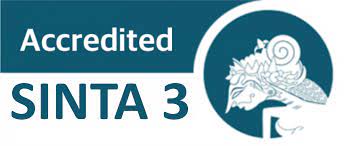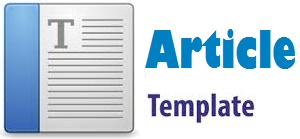The Multisensory Book Design: A Learning Medium for Dyslexic Children Reading the Qur'an Through Reflection on Concrete Objects
Abstract
Keywords
Full Text:
PDFReferences
Basam, F., &; Sulfasyah. (2018). Vakt Multisensory Learning Method as an Effort to Improve Fluent Reading Skills of Grade II Students. Journal of Basic Education Research, 1(1), 18–24. http://journal.unismuh.ac.id/index.php/jrpd
Dirgayunita, Aries, Agutiarini Eka Dheasari, and M. Masyhuri. 2022. "Identification of Early Childhood 'Dyslexic' Learning Difficulties." Al-Athfal 3(1):36–54
Fadilah, A., Nurzakiyah, K.R., Kanya, N.A., Hidayat, S.P., Setiawan, U., 2023. Understanding Media, Objectives, Functions, Benefits and Urgency of Learning Media. Journal of Student Research 1, 01–17. https://doi.org/10.55606/jsr.v1i2.938
Faruq, F., Pratisti, W.D., 2022. Multisensory Learning Models for Dyslexic Children, Effective?: A Systematic Review. IdeGuru 7, 243–248. https://doi.org/10.51169/ideguru.v7i3.392
Filasofa, Lilif Muallifatul Khorida, and Miswati. 2021. "Early Childhood Cognitive Development of People with Dyslexia: A Case Study in Educational Institutions in Indonesia." Journal of Early Childhood and Character Education Vol 1 (1):54–72.
Hasan, R.O., Fatmawati -, Zulmiyetri -, 2017. Improve the ability to recognize Hijaiyah letters through magnetic sheet media in children with moderate intellectual impairment grade VI Slb Karya Padang (single subject research at Slb Karya Padang class VI / C1). Journal of Special Education Research 6. https://doi.org/10.24036/jupe85760.64
Hasanah, Lathipah, Irna Nafisyah, Jabeth Ajeng Pratiwi, and Niken Anggraini Putri. 2022. “Problematika Pembelajaran Daring Anak Mengalami Kesulitan Belajar ‘ Disleksia .’” Jurnal Golden Age 6 (01): 291–302. https://doi.org/https://doi.org/ 10.29408/goldenage.v6i01.5639 Problematika.
Hasanah, Wari’ul, and Lalu Hamdian Affandi. 2020. “Penerapan Strategi Modeling Dengan Media Pasir Untuk Meningkatkan Keterampilan Menulis Huruf Siswa Berkebutuhan Khusus Di Kelas 1 Sdn Repok Puyung.” In Seminar Nasional Pendidikan Inklusif PGSD UNRAM 2020, 104–11. Mataram: Universitas Mataram.
Humaira, S.F., Muplihah, Z., Sari, D.M., Qorina, S.A., Anggraini, P., Herros, P.R.,
Azzahra, N., 2022. Difficulty Learning to Read (Dyslexia) and Difficulty Learning to Write (Dysgraphia) at SDN Cibadak 1 Cikupa District. ALSYS 2, 109–117. https://doi.org/10.58578/alsys.v2i1.147
Imroatun, I., 2017. Hijaiyah Letter Learning for Early Childhood. 1 2, 175–188.
Jatmiko, A., 2016. Understanding and Educating Dyslexic Children. 1 1, 159–166.
Khatib A Latief, ❖ Head, Center for Standards, Quality Development, Lpm Uin Ar-Raniry, Upt Library, delivered at the Seminar, Support Activities, Duta Baca, Aceh Province, Library Office, Aceh Archives, Banda Aceh, 2020. Dyslexia and challenges for leteration activists. https://doi.org/10.13140/RG.2.2.16731.18720
Kawuryan, Fajar. 2012. “Pengaruh Stimulasi Visual Untuk Meningkatkan Kemampuan Membaca Pada Anak Disleksia” 1 (1).
Listyaningrum, Trisna Avi. 2020. "Learning Media For People With Mobile-Based Dyslexia." PP. 104–17 in "Developing the Ability to Research and Write Quality Scientific Papers." Vol. 3.
Maghfiroh, Nur Laili, and Ariga Bahrodin. 2022. "The Effect of Flashcard Learning Media on the Reading Ability of Dyslexic Children." Curriculum Innovation 19 (1):69–78. DOI: 10.17509/jik.v19i1.39571.
Miskiyah, S., Ningsih, N.A., Zahriyah, Y.A., 2023. The implementation of audio-visual learning media on the learning interests of grade 4 students in Mi Tholabuddin 01 Masin. Ibtidaiyyah: Journal of Madrasah Ibtidaiyah Teacher Education 2, 52–62. https://doi.org/10.18860/ijpgmi.v2i1.2135
Muawwanah, Uyu, and Asep Supena. 2021. "The Use of Letter Cards as a Reading Learning Media for Dyslexic Children." Aulad: Journal on Early Childhood 4(2):98–104. doi: 10.31004/aulad.v4i2.120.
Mudinillah, A., 2019. Utilization of the Lectora Inspire application as an interactive learning medium in Arabic lessons. Journal of Science and Technology Research 4, 248–258. https://doi.org/10.32528/ipteks.v4i2.2462
Novitasari, K., &; Utami, N. R. (2022). Analysis of the needs of multisensory learning media for stimulation of early childhood literacy skills. Journal of Cikal Scholar, 02(02), 55–65. https://journal.upy.ac.id/index.php/CIKAL/article/view/2258%0Ahttps://journal.upy.ac.id/index.php/CIKAL/article/download/2258/1415
Nurfadhillah, S., Saridevita, A., Adji, A.S., Valentina, F.R., Astuty, H.W., Devita, N., Destiyantari, S., 2022. Analysis of Reading Learning Difficulties (Dyslexia) and Difficulty Learning to Write (Dysgraphia) of Grade I Students of SDN Tanah Tinggi 3 Tangerang. MASALIQ 2, 114–122. https://doi.org/10.58578/masaliq.v2i1.94
Oktamarina, L., Rosalina, E., Septiani Utami, L., Dzakiyyah, C., Fitri Kurnia Duati, S., Puspa Sari, R., Fajar, M., Utari, N., Meliza, I., Sri Wulandari, S., Purwanti, F., Khumairoh Utami, S., Lasmi, F., Septiani, R., Vyanti, A., Dwi Putri Yanti, V., Juli Yanti, S., Putri Hesa, C., Adelia Putri, M., ... Sales Julita, M. (2022). Symptomatic disorders of dyslexia in early childhood. Multidisciplinary Journal of Bharasumba, 1(1), 101–115.
Primasari, Ika Firma Ningsih Dian, and Asep Supena. 2021. “Meningkatkan Kemampuan Membaca Siswa Disleksia Dengan Metode Multisensori Di Sekolah Dasar.” Jurnal Basicedu 5 (4): 1799–1808. https://jbasic.org/index.php/basicedu/article/view/1055.
Ratmelia, Y., 2018. Moral Values in History Textbooks. Historia: Journal of Historical Educators and Researchers 1, 177–184. https://doi.org/10.17509/historia.v1i2.10711
Rofiah, N.H., 2015. Identification Process: Recognizing Children with Learning Difficulties Types of Dyslexia for Inclusive Primary School Teachers. IJDS 2, 109. https://doi.org/10.14421/ijds.020110
Romadhon, A. C. (2020). The importance of reading and writing and its relation to the progress of the nation's civilization. Journal of Education, 21(1), 1–9.
Rosmawati, Dewi, and Y. Touvan Juni Samodra. 2021. “Pendampingan Anak Yang Memiliki Kesulitan Belajar “Disleksia’’ Di Sekolah.” JPPTK: Jurnal Pendidikan Pembelajaran & Penelitian Tindakan 1 (1): 92–99. https://doi.org/10.53813/jpptk.v1i1.11.
Safarina, Eka Sri, and Hani Susanti. 2018. “PENANGANAN ANAK KESULITAN BELAJAR DISLEKSIA MELALUI PERMAINAN BOWLING KEBERANIAN.” Jurnal Ceria 1 (2): 35–40.
Snowling, Margaret J, Charles Hulme, and Kate Nation. 2020. “Defining and Understanding Dyslexia : Past , Present and Future De Fi Ning and Understanding Dyslexia : Past , Present and Future.” Oxford Review of Education 46 (4): 501–13. https://doi.org/10.1080/03054985.2020.1765756.
Sudiraharja, Dara. 2018. Development Of Flash Card Media For Dyslexic Students To Improve The Ability To Read The Quran At Smp Negeri Satu Satap Bungbulang Garut. Yogyakarta: UIN Sunan Kalijaga.
Surayya, Shahnaz, and Husni Mubarok. 2021. "The Effect of Marbel Reading Application on the Reading Ability of Dyslexic Children." Ibriez : Journal of Science-Based Islamic Basic Education 6(2):194–204. DOI: 10.21154/ibriez.v6i2.165.
Syahroni, Iza, Wasilatur Rofiqoh, and Eva Latipah. 2021. "Features Of Dyslexia In Early Childhood." Journal of Children 8(1):62–77.
Tantri Wulandari, Silvi, and Ferawati Ferawati. 2019. “Pengaruh Penggunaan Kibar Terhadap Keterampilan Membaca Bahasa Arab Pada Anak Disleksia.” Al-Misbah (Jurnal Islamic Studies) 7 (1): 29–38. https://doi.org/10.26555/almisbah.v7i1.1828.
Utami, S. P., &; Irawati, L. (2017). Written language in children with dyslexia (psycholinguistic studies). Linguista: Scientific Journal of Language, Literature, and Its Learning, 1(1), 23–29. https://doi.org/10.25273/linguista.v1i1.1315
Widodo, Arif, Dyah Indraswati, and Agam Royana. 2020. "Analysis of the Use of Serialized Image Media to Improve the Reading Ability of Dyslexic Students in Elementary Sekolsh." MAGISTRA: Media for the Development of Basic Education and Islamic Science 11 (1): 1. DOI: 10.31942/MGS.V11I1.3457.
DOI: https://doi.org/10.18860/abj.v8i2.24345
Refbacks
- There are currently no refbacks.
Copyright (c) 2023 Rosendah Dwi Maulaya
License URL: https://creativecommons.org/licenses/by-sa/4.0/
...............................................................................................................................................................
Mailing Address:
Ruang Jurnal Abjadia, Fakultas Ilmu Tarbiyah dan Keguruan (FITK)
Universitas Islam Negeri (UIN) Maulana Malik Ibrahim Malang
Jalan Gajayana 50 Malang 65144, Jawa Timur, Indonesia
Phone/Faximile: (+62341) 552398, Cell Phone: +62 81 333 666 063
Website: http://ejournal.uin-malang.ac.id/index.php/abjadia
Email: abjadia@uin-malang.com
Abjadia: International Journal of Education. This work is licensed under a Creative Commons Attribution-ShareAlike 4.0 International License.
...............................................................................................................................................................
Indexed by:






